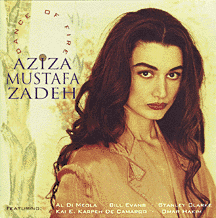|
|
||
|
Dance of Fire
|
||
|
|
Released: 1995 Tracks: 11 Total Time: 69:51 Musicians: Al Di Meola (Acoustic Guitar) Bill Evans (Soprano and Tenor Sax) Stanley Clarke (Acoustic Bass, E-Basses) Kai E. Karpeh De Camargo (5-string E-Basses) Omar Hakim (Drums) |
|
| For
her third album Aziza is able to win over some big names putting
together a fabulous band that let her eleven new compositions shine even
brighter: Stanley Clarke (acoustic + e-bass), Omar Hakim (drums), Bill
Evans (sax), Kai E. Karpeh De Camargo (5-string e-bass), as well as the
incredible Al Di Meola were gathered in order to pool their resources
with the Oriental Princess at New York Sony Studios. And what resources
indeed! This formation works so well that one (at least this
one) would kill to see them perform live.
The strange thing about “Dance of Fire” is that it took me some time to get into it, and it had to do with its rather slow start. I found Boomerang, the album’s opener, to be irritatingly unobtrusive at first hearing. I couldn’t quite tell where it went, what the spirit of this album was, what “kind” of Jazz Aziza would talk on this one. Until I realised that the first four compositions on the album are bound together, much like a suite (they are actually entitled “Dance of Fire Suite”). Accordingly, the four pieces change times from four-four to three-four, with the first and third sharing time and the second and last respectively. So, Boomerang really is the first movement in this suite, giving way to the title track Dance of Fire. This second movement starts out in a similarly unspectacular fashion, with a beautifully simple melody, but grows and ramifies into an iridescent, majestic waltz, and is certainly the heart piece in the suite. It is awesome how well Di Meola’s arpeggios fit in here. After Shereazadeh (!), a short track taking up and extending the theme of Boomerang, punning about another oriental storyteller, the suite eventually merges into Aspiration, for a final, very upbeat last movement, with ample chance for Di Meola to shine. But the dance ain’t over yet! What follows is not only a stunningly funny and original piece of music (including for the first time the whole ensemble if I’m not mistaken), but also the first ever rap in Azeri! And yes, the song is about a “bad girl” but it is more of an invocation, since Bana Gel doesn’t mean “bad girl” but, simply, “Come to me!” Do we detect a sort of alliance here?Part of the fun in this piece is to see how its character shifts once the rein is taken over by the respective solos: starting out with a Spanish/Moorish/oriental guitar it sets the tone for Aziza’s rap/song, which is in time replaced by a purely instrumental part, where the various artists take turns to add their threads to this tapestry. There is a passage of almost 4 minutes solos where Aziza keeps completely in the background, only to initiate the last chorus/invocation that brings the song to a rousing end. |
Entirely devoid of any oriental
influence is the next song. Shadow is a slow, melancholic,
and 100% “pure” Jazz ballade. with sax, acoustic bass and piano
underlining this traditional locale. Not that we actually need it, but
this piece is proof of how thoroughly Aziza knows her way around the
world of Jazz. Passion
is much closer to classical harmonies than Jazz, and it is basically
variations of a leitmotif, much like Character, if more complex.
The passionate thing about it is, I think, how these harmonic and
rhythmic variations are brought about, with what understanding for
storytelling, for tension, timing and effect. Once more, Di Meola’s
runs are almost imperceptible for sheer speed. Spanish Picture
is probably the most demanding from point of view of melody because it
is the most lyrical of the tracks. It shows how much Aziza thinks with
her voice, since it is the voice that carries and shapes the melody, the
lyrics that dictate the rhythm and phrasing of the runs. The beat is 3/4
(6/8) for the most time, but at times shifts the accent to counting 3s
rather than 4s... Another waltz is the penultimate
track on this album. This track is reminiscent of Cicero’s or
Loussier’s “Bach meets Jazz” interpretation although it follows
more the romantic composers such as Rachmaninoff, but the effect is
similar. And it leaves us with an important promise: To Be
Continued! Father,
the last track, is another dedication to Vagif Mustafa Zadeh and his
musical and spiritual legacy. A pensive, lamenting song, unsurprisingly
the most ethnically marked of all tracks, with only the most sparing and
delicate accompaniment by Hakim and Clark. Dance
of Fire is certainly Aziza’s most mature album to date,
profiting enormously, of course, from the wonderful musical talents
brought together here. The ease with which these musicians take up
Aziza’s compositions and how they manage to completely integrate into
her musical cosmos may betray the time it took them to get used to her
music and the hard work and that went into the making of this album. On
the other hand, it shows that Aziza knows exactly what she wants… and
she seems to get it all! |
|
